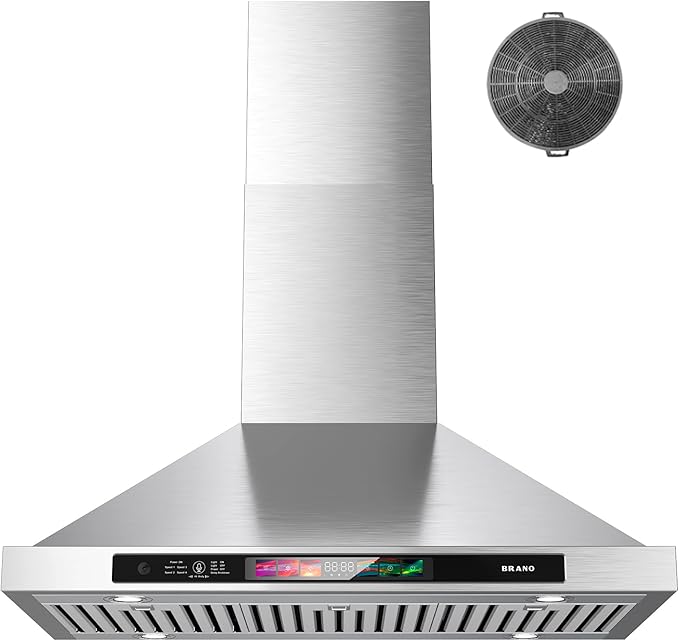A range hood is an essential kitchen appliance that often goes unnoticed despite its importance. It not only keeps your kitchen clean and odor-free but also contributes to a healthier cooking environment. If you are planning to install a range hood or simply want to learn more about it, this comprehensive guide will walk you through everything you need to know about range hoods, their benefits, types, installation, and maintenance.

What Is a Range Hood?
A range hood, also known as a vent hood or exhaust hood, is a device installed above your cooktop or stove. Its primary purpose is to remove smoke, steam, grease, and cooking odors from your kitchen. The hood works by sucking in air through a fan and either venting it outside or filtering and recirculating it back into the kitchen.
Why Do You Need a Range Hood?
Having a range hood in your kitchen provides several benefits:
1. Improved Air Quality :
Cooking produces smoke, steam, and airborne grease that can degrade indoor air quality. A range hood effectively removes these pollutants, leaving your kitchen fresh and breathable.
2. Odor Control :
Cooking strong-smelling foods like fish or spices can leave lingering odors. A range hood helps eliminate these smells quickly.
3. Reduced Grease Build-Up :
By capturing grease particles, a range hood prevents them from settling on your kitchen walls, cabinets, and countertops, making cleaning easier.
4. Enhanced Kitchen Lighting :
Most range hoods come with built-in lights that illuminate your cooking area, making it easier to monitor food preparation.
5. Increased Property Value :
A functional and aesthetically pleasing range hood can boost your kitchen’s appeal and add value to your home.
Types of Range Hoods
There are various types of range hoods to suit different kitchen layouts and preferences. Let’s explore the main categories:
1. Under-Cabinet Range Hoods
These are mounted beneath kitchen cabinets, making them a popular choice for compact kitchens. They are space-saving and effective.
2. Wall-Mounted Range Hoods
Installed directly on the wall above the cooktop, these hoods often feature a chimney design that vents air outside. They’re ideal for kitchens without overhead cabinets.
3. Island Range Hoods
Designed for kitchens with an island cooktop, these hoods hang from the ceiling. They’re typically larger and more stylish to serve as a centerpiece.
4. Downdraft Range Hoods
These are installed alongside the cooktop and pull air downward instead of upward. They’re less common but work well in minimalist kitchens.
5. Ductless Range Hoods
These recirculate air back into the kitchen after filtering it. They are easier to install but may require frequent filter replacement.
Key Features to Consider
When selecting a range hood, keep the following factors in mind:
1. Size
The hood should be as wide as or slightly wider than your cooktop to ensure optimal performance. Common sizes range from 24 inches to 48 inches.
2. Airflow (CFM)
CFM (Cubic Feet per Minute) measures the airflow capacity of a range hood. For heavy-duty cooking, opt for a model with higher CFM.
3. Noise Level
Range hoods can be noisy. Look for models with low sones (a unit measuring sound) or adjustable fan speeds for quieter operation.
4. Filter Type
- Aluminum Mesh Filters: Affordable but need frequent cleaning.
- Baffle Filters: Durable and efficient for grease removal.
- Charcoal Filters: Essential for ductless hoods to trap odors.
5. Lighting
LED lights are energy-efficient and provide excellent illumination. Ensure the range hood has adequate lighting for your cooking needs.
6. Design and Finish
From stainless steel to glass, choose a design that complements your kitchen decor.
Installation Tips
Installing a range hood can be a DIY project, but it’s best to hire a professional for complex setups. Here are some key installation tips:
- Positioning: Install the hood 20-30 inches above the cooktop for optimal performance.
- Ductwork: Use smooth, straight ducts to minimize airflow resistance. Avoid flexible ducts whenever possible.
- Electrical Requirements: Ensure proper wiring and a dedicated power outlet.
- Wall vs. Ceiling Mount: Choose the appropriate mounting option based on your kitchen layout.
Maintenance and Cleaning
Regular maintenance ensures your range hood functions efficiently. Follow these steps:
1. Clean the Filters
- Wash aluminum or baffle filters in warm soapy water every 2-4 weeks.
- Replace charcoal filters every 3-6 months.
2. Wipe the Exterior
Clean the hood’s surface with a damp cloth and mild detergent to remove grease and grime.
3. Check the Ducts
Inspect the ductwork annually to ensure it’s free of blockages.
4. Test the Fan
Run the fan at all speeds to confirm it’s working properly.
Energy Efficiency and Range Hoods
To reduce energy consumption:
- Choose a range hood with an Energy Star rating.
- Use LED lighting.
- Operate the fan at a lower speed when possible.
Top Range Hood Brands to Consider
Here are some reputable brands known for quality range hoods:
- Broan-NuTone
- ZLINE Kitchen and Bath
- Faber
- Cosmo
- Kobe Range Hoods
Conclusion
A range hood is an indispensable part of any modern kitchen, enhancing both functionality and aesthetics. By understanding the different types, features, and maintenance tips, you can select the perfect range hood that suits your needs. Whether you’re renovating your kitchen or setting up a new one, investing in a good range hood will significantly improve your cooking experience and overall kitchen environment.
Make your kitchen the heart of your home with a range hood that combines style, efficiency, and convenience!

